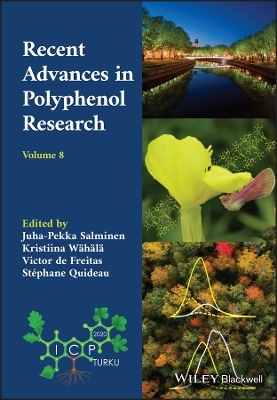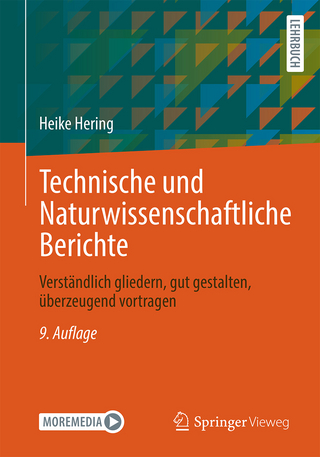
Recent Advances in Polyphenol Research, Volume 8
Wiley-Blackwell (Verlag)
978-1-119-84476-1 (ISBN)
This eighth volume of the highly regarded Recent Advances in Polyphenol Research series is edited by Juha-Pekka Salminen, Kristiina Wähälä, Victor de Freitas, and Stéphane Quideau, and brings together chapters written by some of the leading experts working in the polyphenol sciences today. Topics covered include:
Structure, reactivity and synthesis
Bioactivity and bioavailability
Metabolomics, targeted analysis and big data
Quality control & standardization
Biogenesis and functions in plants and ecosystems
Biomaterials & applied sciences
Distilling the most recent and illuminating data available, this new volume is an invaluable resource for chemists, biochemists, plant scientists, pharmacognosists and pharmacologists, biologists, ecologists, food scientists and nutritionists.
Juha-Pekka Salminen, current Communication Manager of Groupe Polyphénols (board member since 2018), is Full Professor of Natural Compound Chemistry at the University of Turku, Finland. His research group specializes in analytical chemistry, chemical ecology and bioactivity studies of large polyphenols, with a focus on ellagitannins and proanthocyanidins and their distribution and significance in the plant kingdom. Kristiina Wähälä, current Vice-President of the Groupe Polyphénols (2012–2014, 2018–2020) is Professor of Organic Chemistry at the University of Helsinki, Finland. Her research is focused on synthesis, analysis, and isotopical labelling of plant polyphenols and their metabolites in humans in connection with drug discovery and binding studies to target enzymes. The focus on her chemical synthesis is on environmentally benign methods, green chemistry and biomass utilization. Victor de Freitas, former President of the Groupe Polyphénols (2016–2021), is Full Professor at the Faculty of Sciences of the University of Porto, Portugal. His research on polyphenols include: structural characterization, chemical transformations in plants and foods during harvest and storage, influence on the sensory properties of foods (color, astringency and bitterness), and other biological properties. Stéphane Quideau, former President of the Groupe Polyphénols (2008–2012), is Full Professor of Organic and Bioorganic Chemistry at the University of Bordeaux, France, and Senior Member of the “Institut Universitaire de France.” His laboratory is involved in research on plant polyphenol chemistry and chemical biology, with particular interests in ellagitannin chemical reactivity and synthesis, and in polyphenol–protein interactions.
Contributors
Preface
Acknowledgements
1 Lignins and Lignification: New Developments and Emerging Concepts
John Ralph, Hoon Kim, Fachuang Lu, Rebecca A. Smith, Steven D. Karlen, Nuoendagula, Koichi Yoshioka, Alexis Eugene, Sarah Liu, Canan Sener, Daisuke Ando, Mingjie Chen, Yanding Li, Leta L. Landucci, Sally A. Ralph, Vitaliy I. Timokhin, Wu Lan, Jorge Rencoret, José C. del Río
1.1 Introduction
1.2 The monolignol pathway and interacting pathways -- New lignins
1.3 Lignin conjugates, 'clip-offs' -- new discoveries, and enhancing levels
1.4 Features of lignification, and the possibility of new polymerization pathways
1.5 The value of model studies and synthesis -- a reminder
1.6 New or improved analytics
1.7 Conclusions and Opportunities
2 Synthesis of epigallocatechin gallate, nobiletin and their derivatives for chemical-biology studies
Tomohiro Asakawa, Makoto Inai and Toshiyuki Kan
2.1 Synthetic investigations of catechin derivatives
2.2 Synthesis and application of fluorescent catechin probes
2.3 Generation of catechin antibody
2.4 PET imaging of biodistribution of catechin
2.5 Practical synthesis of nobiletin
2.6 Derivatization of desmethyl nobiletins
2.7 PET imaging of biodistribution of nobiletin
2.8 Synthesis and application of fluorescent nobiletin probe
2.9 Conclusions
3 Procyanidins in the Onset and Progression of Colorectal Cancer: Recent Advances and Open Questions
Wei Zhu, Gerardo G. Mackenzie and Patricia I. Oteiza
3.1 Introduction
3.2 Procyanidins:chemistry and metabolism
3.3 Procyanidins and CRC: epidemiological evidence
3.4 Procyanidins and CRC: rodent studies
3.5 Procyanidins and CRC: mechanisms of actions
3.6 Conclusions and open questions
3.7 Acknowledgements
4 The Potential of Low Molecular Weight (Poly)phenol Metabolites for Attenuating Neuroinflammation and Treatment of Neurodegenerative Diseases
Daniela Marques, Rafael Carecho, Diogo Carregosa and Cláudia Nunes dos Santos
4.1 Introduction - Neurodegenerative disorders, dietary (poly)phenols and neuroinflammation
4.2 (Poly)phenols metabolism and distribution
4.3 (Poly)phenol metabolites and their brain permeability
4.4 LMW (poly)phenols metabolites as effectors for attenuating neuroinflammation
4.5 Concluding remarks
5 Deciphering Complex Natural Mixtures through Metabolome Mining of Mass Spectrometry Data: the Plant Specialized Metabolome as a Case Study
Justin J.J. van der Hooft, Madeleine Ernst, Daniel Papenberg, Kyo Bin Kang, Iris F. Kappers, Marnix H. Medema, Pieter C. Dorrestein, and Simon Rogers
5.1 Introduction
5.2 Materials and methods
5.3 Results and discussion
5.4 Current limitations
5.5 Conclusions
5.6 Outlook
5.7 Acknowledgements
6 Application of MS-based Metabolomics to Investigate Biomarkers of Apple Consumption Resulting from Microbiota and Host Metabolism Interactions
Fulvio Mattivi and Maria M. Ulaszewska
6.1 Introduction
6.2 Materials and methods
6.3 Results and discussion
6.4 Conclusions
7 Non-extractable polyphenols should be systematically included in polyphenols analysis
Enrique Báez-García, Sonia G. Sáyago-Ayerdi and Jara Pérez-Jiménez
7.1 Introduction: the concept of non-extractable polyphenols
7.2 Analysis of non-extractable polyphenols
7.3 Why should non-extractable polyphenols be systematically included in polyphenol analysis?
7.4 Relevance of the determination of non-extractable polyphenols in quality control
7.5. Perspectives
8 Template-mediated engineering of functional metal--phenolic complex coatings
Steve Spoljaric, J.J. Richardson, Yi Ju, Frank Caruso
8.1 Introduction
8.2 Template-mediated techniques to deposit MPNs
8.3 MPN film properties
8.4 MPN surface interactions and applications
8.5 Upscaling considerations and challenges
8.6 Method automation: possibilities and outlook
8.7 Conclusions
9 Highly Efficient Production of Dihydroflavonol 4-Reductases in Tobacco Cells and Refinement of the BuOH-HCl Enzymatic Assay
Lingping Zhu, Saku Mattila, Roosa Matomäki, Lorenzo Mollo, Sharmin Ahamed, Sara M. Abdou, Hany Bashandy and Teemu H. Teeri
9.1 Introduction
9.2 Results
9.3 Materials and methods
9.4 Discussion
10 A long and winding road: the evolution of transcriptional regulation of polyphenol biosynthesis
Cathie Martin, Jie Li and Nick W. Albert
10.1 Introduction
10.2 The importance of R2R3Myb transcription factors (TFs) in the regulation of phenylpropanoid metabolism in plants
10.3 The role of bHLH proteins in the regulation of phenylpropanoid metabolism
10.4 The role of the WDR in the MBW complex in the regulation of polyphenol metabolism
10.5 Additional factors regulating transcriptional control of the MBW complex
10.6 Conclusions
10.7 Acknowledgements
11 Analysis of Proanthocyanidins in Food Ingredients by the 4-(Dimethylamino)cinnamaldehyde Reaction
Daniel Esquivel-Alvarado, Emilia Alfaro-Viquez, Andrew Birmingham, Abigail Kramschuster, Christian G. Krueger, and Jess D. Reed
11.1. Introduction
11.2. Background on the 4-(dimethylamino)cinnalmaldehyde (DMAC) reaction with PACs
11.3. Mechanism of the acid catalyzed DMAC reaction with PACs
11.4 Absorption and emission spectra of the DMAC reaction products
11.5 Standards for the DMAC reaction and accuracy of the method
11.6 Interaction of PAC-DMAC reaction products with Extra-Intestinal Pathogenic Escherichia coli
11.7 Conclusions
12 Reactions of Ellagitannins Related to their Metabolism in Higher Plants
Takashi Tanaka
12.1 Introduction
12.2 Structural variety of ellagitannin acyl groups
12.3 Reactions of the DHHDP group
12.4 Decomposition of 1,4-DHHDP-α-D-glucose
12.5 Amariin as a precursor of geraniin
12.6 Triterpene HHDP esters in Castanopsis sieboldii
12.7 Highly-oxidized ellagitannins in Carpinus japonica
12.8 Similarity of catechin oxidation to oxidation of methyl gallate
12.9 Production mechanism of DHHDP and HHDP
12.10 Oxidative degradation of ellagitannins
12.11 Conclusions
References
Index
| Erscheinungsdatum | 28.02.2023 |
|---|---|
| Verlagsort | Hoboken |
| Sprache | englisch |
| Maße | 170 x 244 mm |
| Gewicht | 936 g |
| Themenwelt | Naturwissenschaften |
| Technik | |
| ISBN-10 | 1-119-84476-2 / 1119844762 |
| ISBN-13 | 978-1-119-84476-1 / 9781119844761 |
| Zustand | Neuware |
| Haben Sie eine Frage zum Produkt? |
aus dem Bereich


